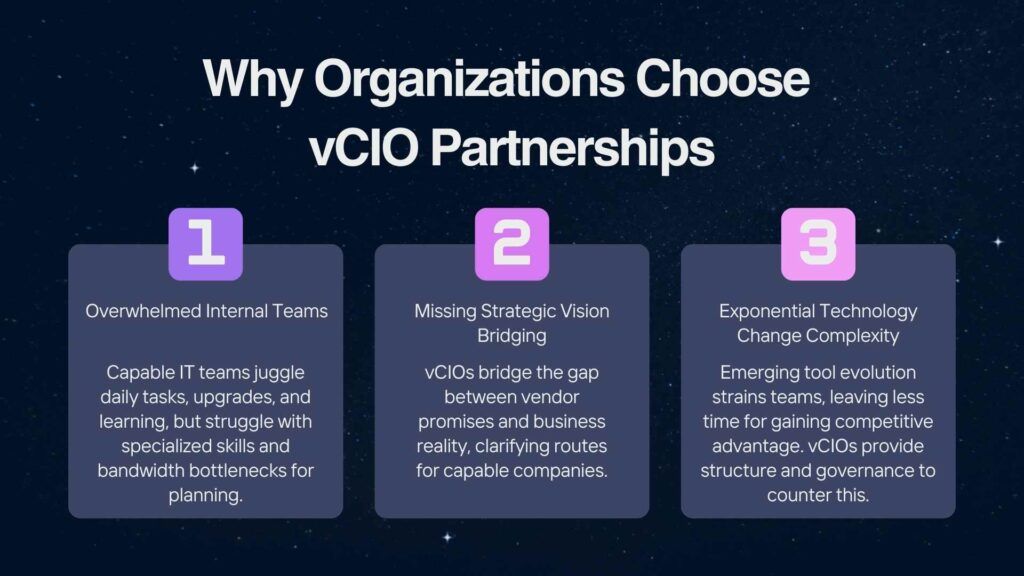Feeling overwhelmed charting technology roadmaps while balancing daily fire drills? You’re not alone. The quickening pace of digital tools evolution strains internal teams. They are split across user support, security, maintenance and innovating for tomorrow. Introducing virtual Chief Information Officers (vCIOs) – a new role. They offer game-changing expertise to guide organizations in customizing and achieving technology plans. This fuels scalable business success.
This blog breaks down precisely how vCIO partnerships strategically help leaders. They are stretched thin trying to bridge painful tech gaps blocking growth today. They are doing this in order to build capabilities and realize goals tomorrow.
Table of Contents
Defining vCIOs’ Strategic Advisor Role
A Virtual CIO (vCIO) provides flexible on-demand technology strategy guidance. They use an advisory partnership model. You do not need to make a major payroll commitment to hire a full-time chief information officer permanently.
Analogy: Like consulting a specialized lawyer for tailored legal guidance or an auditor for financial health checks, vCIOs inject objective, independent insights on infrastructure, automation and security plans calibrated specifically to core business priorities rather than vendor hype cycles. They answer not just what to use, but why it matters.
Most vCIOs carry 15-20+ years of senior management expertise. They have directed large-scale technology modernization initiatives across diverse industries. This multifaceted program leadership gets condensed into tactical virtual engagements. The engagements are designed specifically to upgrade any growth-oriented organization’s maturity.
Think of virtual CIOs as your built-in tech investment advisor and program accomplice. They are expert at technology.
Why Organizations Choose vCIO Partnerships

Rapid digital innovation simultaneously enables and strains companies. The primary drivers behind surging vCIO demand come from 3 key gaps. These gaps separate business goals from technical reality today.
1. Overwhelmed Internal Teams
Even capable IT groups are split across daily user support, major upgrades, and learning continuous app innovations. They also struggle with mastering specialized skills like data science or automation. They also struggle with strategic context switching. Bandwidth bottlenecks hamper planning.
2. Missing Strategic Vision Bridging
Few leaders chart credible paths between shiny vendor promises and business reality. Vendor-agnostic vCIOs bridge this oversight gap that restrains capable companies the most. They do so by clarifying routes.
3. Exponential Technology Change Complexity
Finally, the quickening pace of emerging tools evolution spreads teams thin. They are simply maintaining the status quo. They have much less time to guide competitive advantage. vCIOs bring structure, vetting and governance.
In short, vCIOs fill a pervasive maturity gap. They provide strategic technology oversight and program leadership.
Typical vCIO Experience Profile: Seasoned and Multidimensional
Most reputable providers boast of being able to seamlessly choreograph the breadth of business, technology, and human connections. vCIOs must manage them to function fluidly.
- CIO or Director Level Tech Leadership – Actually managing sizable groups and complex initiatives end-to-end
- Full Cycle Program Leadership – Repeatedly predict, justifying, architecting and executing full modernization projects like cloud migrations, customer experience overhauls or value chain platform transitions
- Vendor Management Expertise – Objectively evaluating hundreds of solution partnerships on capability, viability and value
- Cyber Risk and Compliance Insights – Comprehensively securing environments while satisfying insurance policy demands through certifications like SOC2 and ISO27001
- Proven Business Acumen – Quantifiably tying technology capabilities to financial and operational priority gains
This robust blend empowers vCIO effectiveness bridging capability to reality.
Key Differences From Traditional IT Leadership Roles
vCIOs often have deep or deeper knowledge than internal CIOs. This is due to their broad enterprise perspective, strategic approach, and engagement models. These differences help to distinguish traditional from virtual technology chiefs.
- Oversight Scope – Holistic helicopter view of people, policy, process improvement across silos
- Unbiased Guidance – Free from internal tool politics or sunk cost bias influences
- Economical Scale – Injects niche expertise sans major payroll burden
- Flexible Utilization – On-demand for planning, execution, skill augmentation as fits budget
In short, vCIOs amplify the strengths of internal IT leadership. They have specialized skills and provide impartial program governance. They also optimize existing groups without adding overhead.
Core Areas of vCIO Strategy, Governance and Guidance
Like a visionary compass, vCIOs impart multi-year tech and automation vision spanning:
- Business Goal Alignment – Connecting objectives to technology investments based on merit, not hype
- Infrastructure Optimization – Ensuring stability, efficiency and cyber protection
- Process Automation – Eliminating waste and delays hampering workforce productivity
- Data Centralization – Breaking information silos to generate insights unlocking innovation opportunities
- Supply Chain Modernization – Removing cross-functional friction while improving accuracy
But direction alone drifts without governance enacting change. vCIOs regularly oversee execution from project kickoff through value realization. They ensure business impact by:
- Leading training to boost platform fluency and security practices
- Overseeing vendor app integration and management
- Assigning metrics quantifying technology’s capability advancement impact
Think of virtual CIOs as on-demand multidisciplinary experts. They are changing how organizations, leaders, and teams use and benefit from technology. This happens through accountable, people-focused systems level transformation blueprints.
Partnering and Consumption Models
Companies access vCIO expertise through flexible engagement models. These fit organizational maturity, pace of innovation adoption, and budget like:
- Strategic Planning – Facilitated working sessions yielding multi-year tech investment roadmaps tied to crucial business objectives for capability advancement. Generally refresh annually.
- Project Governance – Oversee complex programs like cloud migrations, customer experience overhauls or automation initiatives ensuring end outcomes match business aims. Align vendors, processes, policies and staff.
- Specialized Skills Augmentation – Plug niche talent gaps in emerging domains like data analytics, IoT architecture, policy maintenance or app vetting through on-demand coaching saving extensive recruiter costs. Enable knowledge transfer.
Some maintain ongoing retainer partnerships. Fast-following entities engage for quarterly strategy tune-ups. They also engage for one-off modernization sprints to contain costs. They do this based on limited change rates. Each approach proves successful given honest internal evaluation.
The common ingredient? Unbiased expertise and accountability unlocking progress despite uncertainty.
Quantifying Returns Through Business Impact
vCIOs use data to design baseline metrics and targeted outcome models. They quantify technology improvements to financials. They base this on priorities like confidence and pace acceleration.
- Monthly cloud cost reductions
- Lead conversion increases from CRM centralization
- Customer satisfaction boosts through digitization
- Security gaps mitigated satisfying audits
- Manual working hour recovery applied to growth initiatives
Most IT investments sit as expenses, not directly driving revenue. Forecasting and linking technology capabilities to overall organizational performance is crucial for credibility. Robust vCIO partnerships make this planning to performance connectivity their core competency. This unlocks substantial capability and consistency gains.
Conclusion
Today’s technology is advancing rapidly. Trying to handle it alone risks failure, given limited specialization. You also have to balance reliable operations, disciplined budgeting, and engaged talent. And no one safely learns complex new vehicles without an expert teaching guide.
Fast-scaling organizations now seek virtual CIOs. They want on-demand, objective, strategic co-pilots. These co-pilots navigate routes and align infrastructure priorities. They help businesses reach their destinations faster. These virtual CIOs do this regardless of internal skill gaps that hamper progress. Their specialized expertise turns IT from a cost center to a consistent competitive advantage. This levels the playing field against disruptors without the gamble.
Realize the power behind data-driven technology. See the certainty it brings through vCIO partners. They are committed to capability advancement and support your team. Then lead markets instead of following them.
FAQs
Objective vCIO audits frequently surface unseen risk areas. These include inadequate business continuity planning and gaps in multi-factor authentication. Neglected insider threat protocols and overpaying for shelfware bloat are also issues. Impartial outside experts ask why.
Ideally, look for 10-15+ years of diverse, enterprise-level senior technology leadership experience. The candidate must have actually managed substantial groups, complex initiatives, security architectures, and multi-million dollar budgets over time. This track record proves multifaceted real-world expertise.
Seasoned vCIOs design baseline and ongoing quantifiable metrics. They model these metrics mathematically to financial and operational statistics. The metrics show how optimized technology KPI improvements enable and accelerate measurable progress against crucial business growth objectives over quarters.

